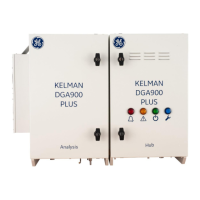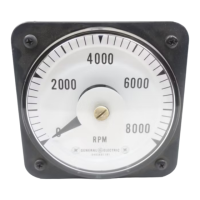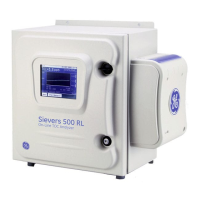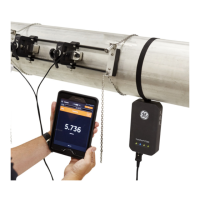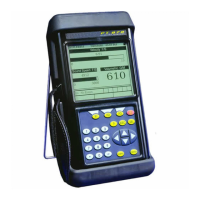5-10 Issue 01, 04/2005 Krautkramer USM 35X
Operation Adjusting the pulser (function group PULS)
POWER (Intensity)
Use the function POWER to set the pulser voltage. You
can choose between two settings:
• high – high voltage
• low – low voltage
The setting high is recommended for all inspections in
which maximum sensitivity is important, e.g. for the
detection of small flaws. Choose the setting low for
broadband probes or if narrow echoes are required (bet-
ter lateral resolution).
– Select the function POWER.
– Use the right-hand rotary knob to choose the required
setting.
DUAL (Pulser-receiver separation)
You can use the function DUAL to activate the pulser-
receiver separation.
• off
Single-element operation; the probe connection
sockets are connected in parallel.
• on
Dual mode for the use with dual-element (TR) probes;
the left-hand socket (red) is connected with the
amplifier input whereas the initial pulse is available at
the right-hand socket (black).
• through
Through-transmission mode for the use with two
separate probes; the receiver is connected with left
(red), the pulser is connected with right (black).
– Select the function DUAL.
– Use the right-hand rotary knob to choose the required
setting.
If the DUAL function is active, the LED D (dual) is on.
5-10 Issue 01, 04/2005 Krautkramer USM 35X
Operation Adjusting the pulser (function group PULS)
POWER (Intensity)
Use the function POWER to set the pulser voltage. You
can choose between two settings:
• high – high voltage
• low – low voltage
The setting high is recommended for all inspections in
which maximum sensitivity is important, e.g. for the
detection of small flaws. Choose the setting low for
broadband probes or if narrow echoes are required (bet-
ter lateral resolution).
– Select the function POWER.
– Use the right-hand rotary knob to choose the required
setting.
DUAL (Pulser-receiver separation)
You can use the function DUAL to activate the pulser-
receiver separation.
• off
Single-element operation; the probe connection
sockets are connected in parallel.
• on
Dual mode for the use with dual-element (TR) probes;
the left-hand socket (red) is connected with the
amplifier input whereas the initial pulse is available at
the right-hand socket (black).
• through
Through-transmission mode for the use with two
separate probes; the receiver is connected with left
(red), the pulser is connected with right (black).
– Select the function DUAL.
– Use the right-hand rotary knob to choose the required
setting.
If the DUAL function is active, the LED D (dual) is on.
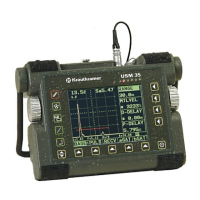
